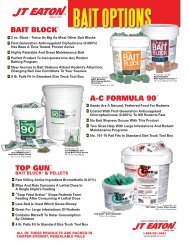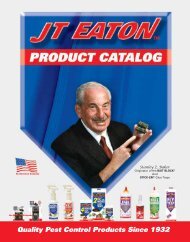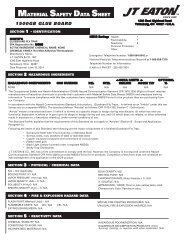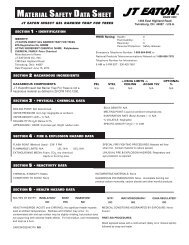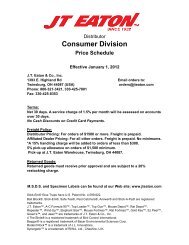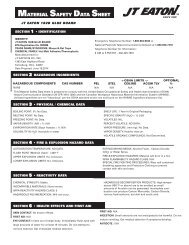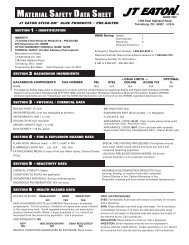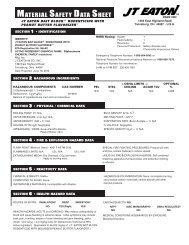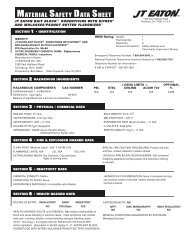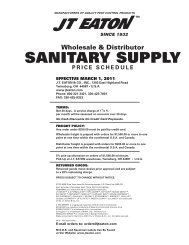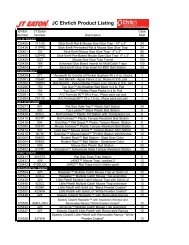Green Rhino Multipurpose Lubricant and Penetrant - JT Eaton
Green Rhino Multipurpose Lubricant and Penetrant - JT Eaton
Green Rhino Multipurpose Lubricant and Penetrant - JT Eaton
Create successful ePaper yourself
Turn your PDF publications into a flip-book with our unique Google optimized e-Paper software.
MATERIAL SAFETY DATA SHEET<br />
1. Product <strong>and</strong> Company Identification<br />
Product Name<br />
CAS #<br />
Product use<br />
Manufacturer<br />
LEGEND<br />
HMIS/NFPA<br />
Severe 4<br />
Serious 3<br />
Moderate 2<br />
Slight 1<br />
Minimal 0<br />
<strong>Green</strong> <strong>Rhino</strong> <strong>Multipurpose</strong> <strong>Lubricant</strong> <strong>and</strong> <strong>Penetrant</strong><br />
Mixture<br />
<strong>Lubricant</strong><br />
<strong>Green</strong> <strong>Rhino</strong> Division of C&D Communications Inc.<br />
57 Old Post Road No 2<br />
<strong>Green</strong>wich, CT 06830<br />
Phone: 1-888-744-6645<br />
Health / 0<br />
Flammability 0<br />
Physical Hazard 0<br />
Personal Protection<br />
A<br />
0<br />
0 0<br />
2. Hazards Identification<br />
Emergency overview<br />
Potential short term health effects<br />
Routes of exposure<br />
Eyes<br />
Skin<br />
Inhalation<br />
Ingestion<br />
Target organs<br />
Chronic effects<br />
Signs <strong>and</strong> symptoms<br />
CAUTION<br />
Contact with eyes may cause irritation.<br />
Eye, Skin contact, Inhalation, Ingestion.<br />
Liquid is mildly irritating to eyes.<br />
Not expected to be a primary skin irritant.<br />
Excessive intentional inhalation may cause respiratory tract irritation <strong>and</strong> central<br />
nervous system effects (headache, dizziness).<br />
May cause stomach distress, nausea or vomiting. Aspiration of material into lungs can<br />
cause chemical pneumonitis.<br />
Eyes.<br />
Prolonged or repeated exposure can cause drying, defatting <strong>and</strong> dermatitis.<br />
Symptoms may include redness, edema, drying, defatting <strong>and</strong> cracking of the skin.<br />
Symptoms of overexposure may be headache, dizziness, tiredness, nausea <strong>and</strong><br />
vomiting.<br />
3. Composition / Information on Ingredients<br />
Ingredient(s) CAS # Percent<br />
Distillates (petroleum), light hydrotreated<br />
Distillates (petroleum), hydrotreated middle<br />
White mineral oil (petroleum)<br />
Naphtha (petroleum), hydrotreated heavy<br />
Naphtha (petroleum), light alkylate<br />
64742-47-8<br />
64742-46-7<br />
8042-47-5<br />
64742-48-9<br />
64741-66-8<br />
7 - 13<br />
30 - 60<br />
30 - 60<br />
3 - 7<br />
3 - 7<br />
Composition comments<br />
Non hazardous by WHMIS Criteria.<br />
4. First Aid Measures<br />
First aid procedures<br />
Eye contact<br />
Skin contact<br />
Inhalation<br />
Flush with cool water. Remove contact lenses, if applicable, <strong>and</strong> continue flushing.<br />
Obtain medical attention if irritation persists.<br />
Flush with cool water. Wash with soap <strong>and</strong> water. Obtain medical attention if irritation<br />
persists.<br />
If symptoms develop move victim to fresh air. If symptoms persist, obtain medical<br />
attention.<br />
#17267 Page 1 of 6 Issue date 18-June-2012
Ingestion<br />
Notes to physician<br />
General advice<br />
Do not induce vomiting. Rinse mouth with water, then drink one or two glasses of water.<br />
Obtain medical attention. Never give anything by mouth if victim is unconscious, or is<br />
convulsing.<br />
Symptoms may be delayed.<br />
If you feel unwell, seek medical advice (show the label where possible). Ensure that<br />
medical personnel are aware of the material(s) involved, <strong>and</strong> take precautions to protect<br />
themselves. Show this safety data sheet to the doctor in attendance.<br />
5. Fire Fighting Measures<br />
Flammable properties<br />
Not flammable by WHMIS/OSHA criteria.<br />
Extinguishing media<br />
Suitable extinguishing media Carbon dioxide. Dry chemical. Foam.<br />
Unsuitable extinguishing media Not available<br />
Protection of firefighters<br />
Specific hazards arising from Not available<br />
the chemical<br />
Protective equipment for<br />
firefighters<br />
Hazardous combustion products<br />
Explosion data<br />
Sensitivity to mechanical<br />
impact<br />
Sensitivity to static discharge<br />
Firefighters should wear full protective clothing including self contained breathing<br />
apparatus.<br />
May include <strong>and</strong> are not limited to: Oxides of carbon.<br />
Not available<br />
Not available<br />
6. Accidental Release Measures<br />
Personal precautions<br />
Methods for containment<br />
Methods for cleaning up<br />
Keep unnecessary personnel away. Do not touch or walk through spilled material. Do<br />
not touch damaged containers or spilled material unless wearing appropriate protective<br />
clothing. Keep people away from <strong>and</strong> upwind of spill/leak.<br />
Stop leak if you can do so without risk. Prevent entry into waterways, sewers,<br />
basements or confined areas.<br />
Before attempting clean up, refer to hazard data given above. Small spills may be<br />
absorbed with non-reactive absorbent <strong>and</strong> placed in suitable, covered, labelled<br />
containers. Prevent large spills from entering sewers or waterways. Contact emergency<br />
services <strong>and</strong> supplier for advice. Never return spills in original containers for re-use.<br />
7. H<strong>and</strong>ling <strong>and</strong> Storage<br />
H<strong>and</strong>ling<br />
Storage<br />
Use good industrial hygiene practices in h<strong>and</strong>ling this material.<br />
Keep out of reach of children. Store in a closed container away from incompatible<br />
materials.<br />
#17267 Page 2 of 6 Issue date 04-May-2007
8. Exposure Controls / Personal Protection<br />
Exposure limits<br />
Ingredient(s)<br />
Distillates (petroleum), hydrotreated middle<br />
Distillates (petroleum), light hydrotreated<br />
Naphtha (petroleum), hydrotreated heavy<br />
Naphtha (petroleum), light alkylate<br />
White mineral oil (petroleum)<br />
Exposure Limits<br />
ACGIH-TLV<br />
Not established<br />
OSHA-PEL<br />
Not established<br />
ACGIH-TLV<br />
Not established<br />
OSHA-PEL<br />
Not established<br />
ACGIH-TLV<br />
Not established<br />
OSHA-PEL<br />
Not established<br />
ACGIH-TLV<br />
Not established<br />
OSHA-PEL<br />
Not established<br />
ACGIH-TLV<br />
Not established<br />
OSHA-PEL<br />
Not established<br />
Engineering controls<br />
Personal protective equipment<br />
Eye / face protection<br />
H<strong>and</strong> protection<br />
Skin <strong>and</strong> body protection<br />
Respiratory protection<br />
General ventilation normally adequate.<br />
Wear safety glasses with side shields.<br />
Not normally required when used as directed. Protective gloves are recommended<br />
for prolonged or repeated exposure.<br />
As required by employer code.<br />
Where exposure guideline levels may be exceeded, use an approved NIOSH respirator.<br />
General hygiene considerations H<strong>and</strong>le in accordance with good industrial hygiene <strong>and</strong> safety practice. When using do not<br />
eat or drink. Wash h<strong>and</strong>s before breaks <strong>and</strong> immediately after h<strong>and</strong>ling the product.<br />
9. Physical & Chemical Properties<br />
Appearance<br />
Color<br />
Form<br />
Odor<br />
Odor threshold<br />
Physical state<br />
pH<br />
Melting point<br />
Freezing point<br />
Boiling point<br />
Flash point<br />
Evaporation rate<br />
Flammability limits in air, lower, %<br />
by volume<br />
Flammability limits in air, upper, %<br />
by volume<br />
Liquid.<br />
Clear<br />
Liquid<br />
Odorless.<br />
Not available<br />
Liquid<br />
Not available<br />
Not available<br />
Not available<br />
268.33 - 307.77 °C (515 - 586 °F)<br />
116.11 °C (241 °F) Pensky-Martens Closed Cup<br />
Not available<br />
Not available<br />
Not available<br />
#17267 Page 3 of 6 Issue date 04-May-2007
Vapor pressure<br />
< 0.1 mmHg @ 70°F (21.1°C)<br />
Vapor density 8.1<br />
Specific gravity<br />
0.81 @ 60°F (15.6°C)<br />
Octanol/water coefficient<br />
Not available<br />
Solubility (H2O)<br />
Insoluble<br />
Auto-ignition temperature<br />
220.00 °C (428 °F)<br />
VOC (Weight %) 0<br />
Viscosity<br />
38.7 SUS @ 100°F (37.8°C)<br />
Percent volatile 0<br />
10. Chemical Stability & Reactivity Information<br />
Chemical stability<br />
Stable under recommended storage conditions.<br />
Conditions to avoid<br />
Do not mix with other chemicals.<br />
Incompatible materials<br />
Oxidizers.<br />
Hazardous decomposition products May include <strong>and</strong> are not limited to: Oxides of carbon.<br />
Possibility of hazardous reactions Not available<br />
11. Toxicological Information<br />
Component analysis - LC50<br />
Ingredient(s)<br />
Distillates (petroleum), hydrotreated middle<br />
Distillates (petroleum), light hydrotreated<br />
Naphtha (petroleum), hydrotreated heavy<br />
Naphtha (petroleum), light alkylate<br />
White mineral oil (petroleum)<br />
Component analysis - Oral LD50<br />
Ingredient(s)<br />
Distillates (petroleum), hydrotreated middle<br />
Distillates (petroleum), light hydrotreated<br />
Naphtha (petroleum), hydrotreated heavy<br />
Naphtha (petroleum), light alkylate<br />
LC50<br />
4.6 mg/l/4h rat<br />
5.2 mg/l/4h rat<br />
Not available<br />
5.04 mg/l/4h rat<br />
Not available<br />
LD50<br />
7400 mg/kg rat<br />
5000 mg/kg rat<br />
5000 mg/kg rat<br />
7000 mg/kg rat<br />
White mineral oil (petroleum)<br />
Effects of acute exposure<br />
Eye<br />
Skin<br />
Inhalation<br />
Ingestion<br />
Sensitization<br />
Chronic effects<br />
Carcinogenicity<br />
Mutagenicity<br />
Reproductive effects<br />
Teratogenicity<br />
5000 mg/kg rat<br />
Liquid is mildly irritating to eyes.<br />
Not expected to be a primary skin irritant.<br />
Excessive intentional inhalation may cause respiratory tract irritation <strong>and</strong> central<br />
nervous system effects (headache, dizziness).<br />
May cause stomach distress, nausea or vomiting. Aspiration of material into lungs can<br />
cause chemical pneumonitis.<br />
Non-hazardous by WHMIS/OSHA criteria.<br />
Non-hazardous by WHMIS/OSHA criteria.<br />
Non-hazardous by WHMIS/OSHA criteria.<br />
Non-hazardous by WHMIS/OSHA criteria.<br />
Non-hazardous by WHMIS/OSHA criteria.<br />
Non-hazardous by WHMIS/OSHA criteria.<br />
#17267 Page 4 of 6 Issue date 04-May-2007
Ecotoxicity<br />
Ecotoxicity - Freshwater Algae Data<br />
12. Ecological Information<br />
This product has not been tested.<br />
Naphtha (petroleum), light alkylate 64741-66-8 72 Hr EC50 Selenastrum capricornutum: 30000 mg/L<br />
Ecotoxicity - Freshwater Fish Species Data<br />
Distillates (petroleum),<br />
hydrotreated middle<br />
Distillates (petroleum), light<br />
hydrotreated<br />
Naphtha (petroleum),<br />
hydrotreated heavy<br />
64742-46-7 96 Hr LC50 Pimephales promelas: 35 mg/L [flow-through]<br />
64742-47-8 96 Hr LC50 Pimephales promelas: 45 mg/L [flow-through]; 96 Hr LC50 Lepomis<br />
macrochirus: 1740 mg/L [static]<br />
64742-48-9 96 Hr LC50 Pimephales promelas: 2200 mg/L<br />
W hite mineral oil (petroleum) 8042-47-5 96 Hr LC50 Lepomis macrochirus: >10000 mg/L<br />
Ecotoxicity - Water Flea Data<br />
Distillates (petroleum), light 64742-47-8 96 Hr LC50 Den-dronereides heteropoda: 4720 mg/L<br />
hydrotreated<br />
Naphtha (petroleum),<br />
64742-48-9 96 Hr LC50 Chaetogammarus marinus: 2.6 mg/L<br />
hydrotreated heavy<br />
Naphtha (petroleum), light alkylate 64741-66-8 48 Hr LC50 Mysidopsis bahia: 2 mg/L<br />
Environmental effects<br />
Not available<br />
Aquatic toxicity<br />
Not available<br />
Persistence / degradability<br />
Not available<br />
Bioaccumulation / accumulation Not available<br />
Partition coefficient<br />
Not available<br />
Mobility in environmental media Not available<br />
Chemical fate information<br />
Not available<br />
13. Disposal Considerations<br />
Waste codes<br />
Disposal instructions<br />
Waste from residues / unused<br />
products<br />
Contaminated packaging<br />
Not available<br />
Dispose in accordance with all applicable regulations.<br />
Not available<br />
Not available<br />
14. Transport Information<br />
Department of Transportation (DOT)<br />
Not regulated as dangerous goods.<br />
Transportation of Dangerous Goods (TDG)<br />
Not regulated as dangerous goods.<br />
15. Regulatory Information<br />
Canadian federal regulations<br />
US Federal regulations<br />
This product has been classified in accordance with the hazard criteria of the Controlled<br />
Products Regulations <strong>and</strong> the MSDS contains all the information required by the<br />
Controlled Products Regulations.<br />
This product is not known to be a "Hazardous Chemical" as defined by the OSHA<br />
Hazard Communication St<strong>and</strong>ard, 29 CFR 1910.1200.<br />
All components are on the U.S. EPA TSCA Inventory List.<br />
CERCLA/SARA Hazardous Substances - Not applicable.<br />
Occupational Safety <strong>and</strong> Health Administration (OSHA)<br />
29 CFR 1910.1200 hazardous No<br />
chemical<br />
CERCLA (Superfund) reportable quantity<br />
None<br />
#17267 Page 5 of 6 Issue date 04-May-2007
Superfund Amendments <strong>and</strong> Reauthorization Act of 1986 (SARA)<br />
Hazard categories<br />
Immediate Hazard - No<br />
Delayed Hazard - No<br />
Fire Hazard - No<br />
Pressure Hazard - No<br />
Reactivity Hazard - No<br />
Section 302 extremely<br />
No<br />
hazardous substance<br />
Section 311 hazardous chemical No<br />
Clean Air Act (CAA)<br />
Not available<br />
Clean Water Act (CWA)<br />
Not available<br />
Safe Drinking Water Act (SDWA) Not available<br />
Drug Enforcement Agency (DEA) Not available<br />
Food <strong>and</strong> Drug Administration Not available<br />
(FDA)<br />
WHMIS status<br />
Not Controlled<br />
State regulations<br />
This product does not contain a chemical known to the State of California to cause<br />
cancer, birth defects or other reproductive harm.<br />
Inventory name<br />
Country(s) or region Inventory name On inventory (yes/no)*<br />
Canada Domestic Substances List (DSL) Yes<br />
Canada<br />
United States & Puerto Rico<br />
Non-Domestic Substances List (NDSL)<br />
Toxic Substances Control Act (TSCA) Inventory<br />
No<br />
Yes<br />
A "Yes" indicates that all components of this product comply with the inventory requirements administered by the governing country(s)<br />
16. Other Information<br />
Disclaimer<br />
Information contained herein was obtained from sources considered technically accurate<br />
<strong>and</strong> reliable. While every effort has been made to ensure full disclosure of product<br />
hazards, in some cases data is not available <strong>and</strong> is so stated. Since conditions of actual<br />
product use are beyond control of the supplier, it is assumed that users of this material<br />
have been fully trained according to the requirements of all applicable legislation <strong>and</strong><br />
regulatory instruments. No warranty, expressed or implied, is made <strong>and</strong> supplier will not<br />
be liable for any losses, injuries or consequential damages which may result from the<br />
use of or reliance on any information contained in this document.<br />
Issue date<br />
04-May-2007<br />
Effective date<br />
15-Jun-2006<br />
Expiry date<br />
15-Jun-2009<br />
Prepared by Dell Tech Laboratories Ltd. (519) 858-5021<br />
#17267 Page 6 of 6 Issue date 04-May-2007




